Yayoi Kusama – Important Solo/Group Shows 1980s-2010s
Hello everyone,
This blog will be about Yayoi Kusama’s international breakthrough and her important solo/group shows from the 1980s via the 2000s to the 2010s.
1980s-1990s
During the beginning of the 80s it was quiet around Kusama, who still lived in Japan, until a number of retrospectives revived international interest in her in the late 1980s and 1990s.
One of them was Yayoi Kusama: A Retrospective which was the first critical survey of Yayoi Kusama presented at the Centre for International Contemporary Arts (CICA) in New York in 1989.
This led to the artist being invited to represent Japan at the 1993 Venice Biennale.
She installed a dazzling mirrored room filled with small pumpkin sculptures where she resided in a colour-coordinated magician’s attire.
Kusama went on to create a huge, yellow pumpkin sculpture covered with an optical pattern of black spots. The pumpkin came to represent for her a kind of alter-ego.
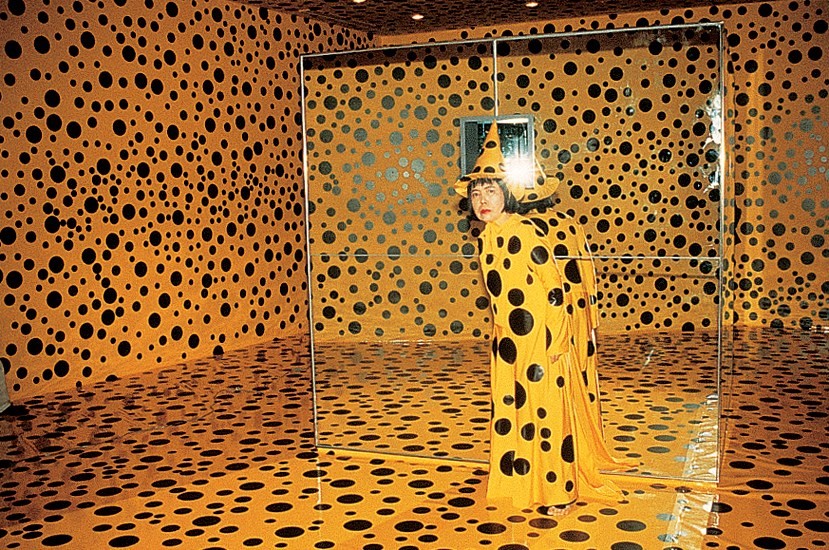
© https://www.dazeddigital.com/art-photography/article/41697/1/when-yayoi-kusama-was-forced-to-start-her-career-again-infinity-dogwoof
After the biennale she had an exhibition, starting in 1998, travelling around the USA beginning in LA at LACMA called: “Love Forever: Yayoi Kusama, 1958–1968“. This show brought many of Kusama’s paintings, drawings, collages, sculptures, and installation works together for the first time.
The exhibition then travelled to the Museum of Modern Art in New York, the Walker Art Centre in Minneapolis and ended in 1999 at the Museum of Contemporary Art in Tokyo.
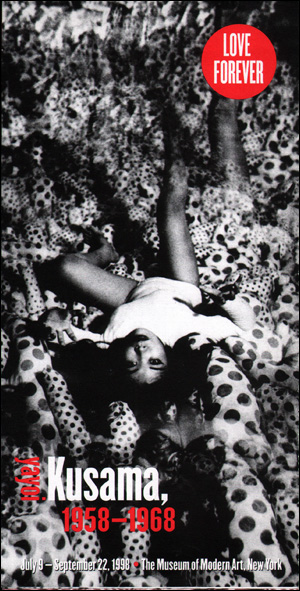
© https://specificobject.com/objects/info.cfm?object_id=29946#.YkHXJTXRZhE
2000s
Kusama’s first ever UK exhibition “Yayoi Kusama” was at the Serpentine Gallery in London in 2000.
This exhibition included paintings, collages, watercolours, sculptures and a documentation of performances and films, all of which explored Kusama’s obsessions with dots, nets, food, and sex.
The centrepiece of the show was a re-interpretation of Kusama’s 1966 landmark work, The Driving Image where she vigorously covered surfaces of mannequins and household furniture with her painted signature style. Other works in the exhibition included a life-size rowboat, a room-size snake covered in stuffed and painted phallic protrusions and an interactive, inflatable painting.

Installation view from the exhibition Yayoi Kusama, Serpentine Gallery, London
Photograph © 2000 Stephen White

Installation view from the exhibition Yayoi Kusama, Serpentine Gallery, London
Photograph © 2000 Stephen White
A mentionable exhibition “YAYOI KUSAMA Arbeiten aus den Jahren 1949 bis 2003” was at Kunstverein Braunschweig from 2003-2004, it also included an infinity room called “Dots Obsession” with inflatable polka dotted balloons.
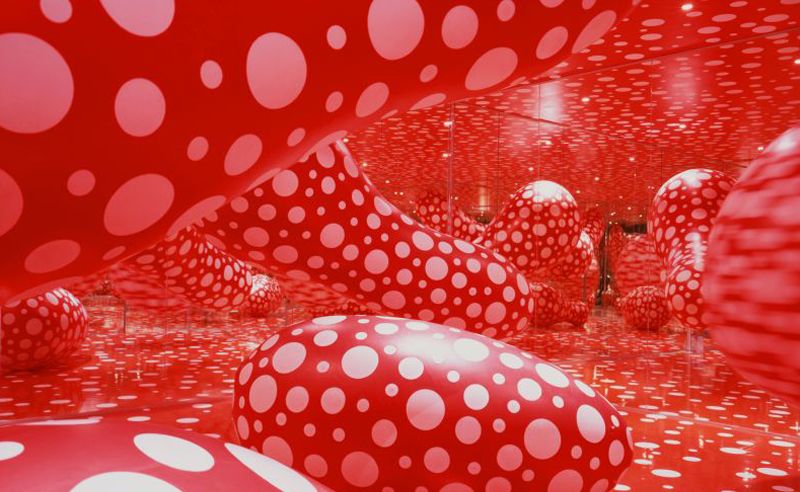
© https://www.tatlerasia.com/culture/arts/yayoi-kusama-fashion-design-retrospective-exhibition
She had a big exposition at Haus der Kunst in Munich in 2007 called “Dots Obsession – Love Transformed into Dots“, which shows her Polka Dots as huge pink balloons sprinkled with black dots.

© https://www.art-scene.tv/de/events/detailansicht/cr/all/c/infinity-mirrors.html?tx_zvmcalendar_pi1[page]=1
The exhibition “Yayoi Kusama – Mirrored Years” started at Museum Boijmans Van Beuningen in Rotterdam in 2008 and then travelled to the Museum of Contemporary Art, Sydney in 2009 and ended at the City Gallery Wellington, New Zealand in 2010.
The show counterbalanced her early installations, films, and sculptures from the 1960s with more recent works. The juxtaposition of renowned installations such as the ‘Infinity Mirror Room – Phalli’s Field‘ (1965) or ‘Narcissus Garden‘ (1966) with recent mirror installations such as ‘Fireflies on the Water‘ and ‘Invisible Life‘ (2000) as well as new sculptures such as ‘Soaring Spirits‘ (2008-2009) provided insight into a career spanning more than 40 years.
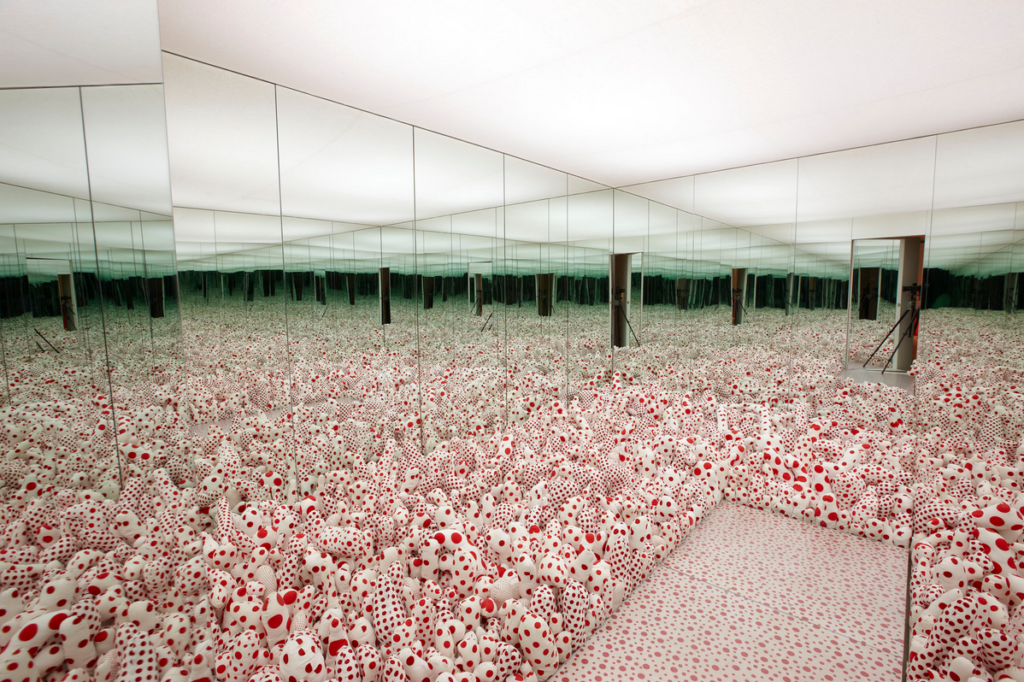
Image courtesy the artist, Yayoi Kusama Studio, Victoria Miro Gallery, London and Ota Fine Arts, Tokyo © the artist
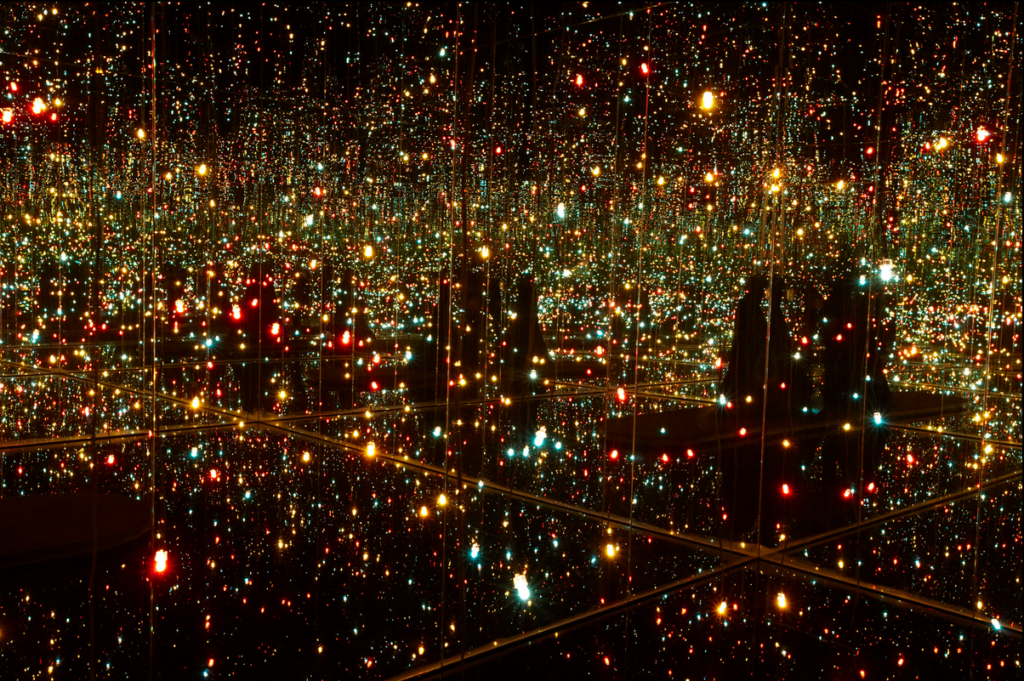
Image courtesy the artist, Yayoi Kusama Studio, Victoria Miro Gallery, London and Ota Fine Arts, Tokyo © the artist

Image courtesy the artist, Yayoi Kusama Studio, Victoria Miro Gallery, London and Ota Fine Arts, Tokyo © the artist
Besides the aforementioned works, a variety of other sculptures, films and happenings conceived by Kusama in the 1960s was presented in combination with similar works from recent years.
An installation of 50 new paintings that she produced diligently between 2005 and 2007, was also included in the exhibition.
In 2009 Kusama had an exhibition at Gagosian Gallery in Beverly Hills called “Flowers That Bloom at Midnight”. The gallery space was full of triffid-like flowers ranging from 1 to 4 meters in height. They were arranged like an artificial garden and had a psychedelic effect on the visitors.
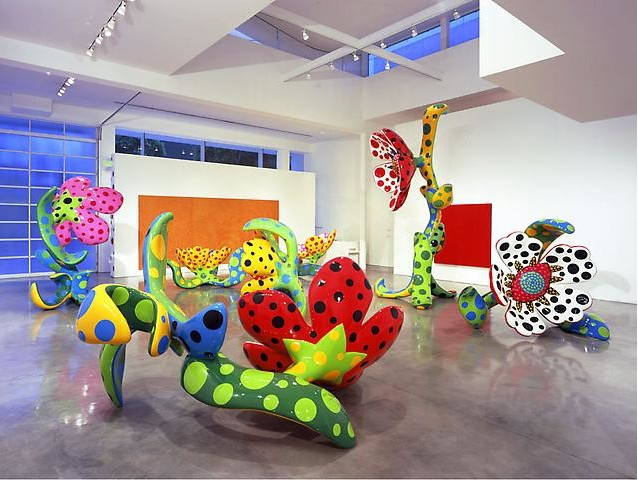
© https://gagosian.com/exhibitions/2009/yayoi-kusama-flowers-that-bloom-at-midnight/
2010s
In 2010 Yayoi Kusama took part in the exhibition “Mind and Matter: Alternative Abstractions, 1940s to Now” at the MOMA in New York. The show presented a dozen international artists with focus on organic forms and materials that appear flexible and pliable, craft-based techniques and often had an engagement to sexuality and gender. All works were from the collection of MOMA and included prints, drawings, books, and sculptures by artists like Mona Hatoum, Anna Maria Maiolino and Louise Bourgeois.
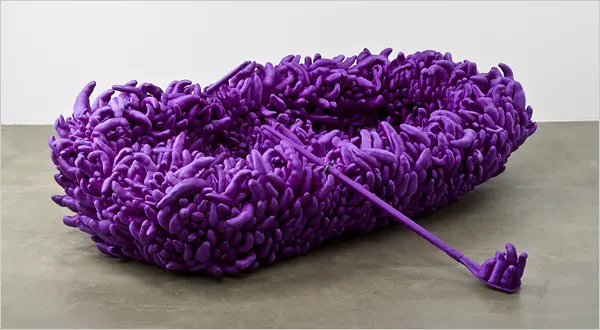
© https://www.nytimes.com/2010/06/18/arts/design/18galleries-001.html
In 2011 Kusama had an exhibition at the Gagosian Gallery in Rome called “YAYOI KUSAMA”, showing her most recent sculptures and paintings. The exposition included some of her pumpkin sculptures which were dotted, one of her trademarks. Two self-portraits were also part of the show presenting her like a Russian icon. Her installation from the 33rd biennale “Narcissus Garden” was part of the exhibition as well.

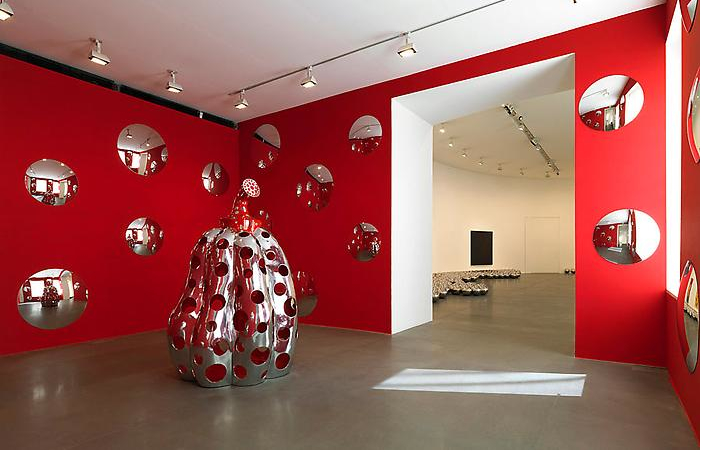
In 2012 an important retrospective was held at Tate Modern in London, I visited it myself!
The exhibition encompassed all her types of works including painting, drawing, sculpture, film, performance and immersive installation. Kusama is well-known for her dot patterns, making her create the “Obliteration Room”. This space had an interactive focus, inviting the visitors to cover the whole extremely white room with stickers, turning it into an explosion of colour. Thousands of stickers were stuck on every reachable surface.

© https://www.theguardian.com/artanddesign/gallery/2012/feb/01/obliteration-room-yayoi-kusama-in-pictures
© Photograph: Stuart Addelsee/Rex Features/Ota Fine Arts, Tokyo
Another one of her famous installations, was called “Accumulation on Cabinet” which included a couch, shoes, a stool, a dress all covered in handmade phalluses. This goes back to her childhood that formed an unnatural relation to sex.

© https://artwizard.eu/yayoi-kusama-network-of-infinity-ar-87
Another important space was the Mirrored Infinity Room – Filled with the Brilliance of Life from 2011. Visitors pass through this room on a walkway made of mirrored tiles. The mirrors are also on the walls and ceiling, and a shallow pool of water covers the floor surrounding the walkway. This and the hundreds of small, round LED lights flashing on and off give the viewer the feeling of being in a seemingly endless space.
The work was made specifically for the artist’s retrospective exhibition Yayoi Kusama held at Reina Sofia, Madrid; Centre Pompidou, Paris; Tate Modern, London, and the Whitney Museum of American Art, New York, in 2011 and 2012. It was the largest mirror installation she had made up to that date.
It was a varied, spectacular show of a truly unique artist. There had never been an exhibition of this size of her work in the UK before and therefore, was an unmissable opportunity for both Kusama fans and those new to her work.
This exhibition made Kusama into one of my favourite artists!

© https://www.victoria-miro.com/artists/31-yayoi-kusama/works/artworks19443/
Another important solo exhibition of Yayoi Kusama was called “A Dream I Dreamed” which went on tour only through Asia, starting in Daegu, South Korea in 2013, travelling through Shanghai, China and ending in Taichung, Taiwan in 2015.
The exhibition comprised 110 works, including paintings, sculptures, installations, and a documentary film.
Her paintings were infinity nets, made with acrylic on canvas and being same-sized.
Kusama also had a room with three pumpkins in three different sizes, patterned with her famous polka dots. She added six dog sculptures to her show all in different colours looking like they’re barking.

© https://artmuseum.daegu.go.kr/eng/exhibition/pop_exhibition1.html?cid=0&sid=41&gubun1=2&gubun2=2&start=
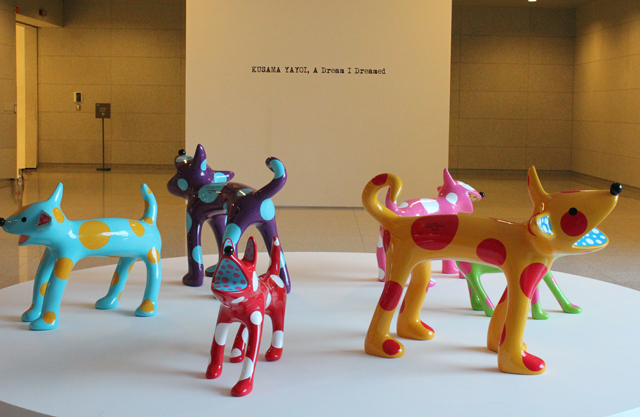
© https://artmuseum.daegu.go.kr/eng/exhibition/pop_exhibition1.html?cid=0&sid=41&gubun1=2&gubun2=2&start=
Of course, the mirror rooms cannot be missing, below is the one called “Infinity Mirrored Room, Love Forever” which was originally created in 1994.
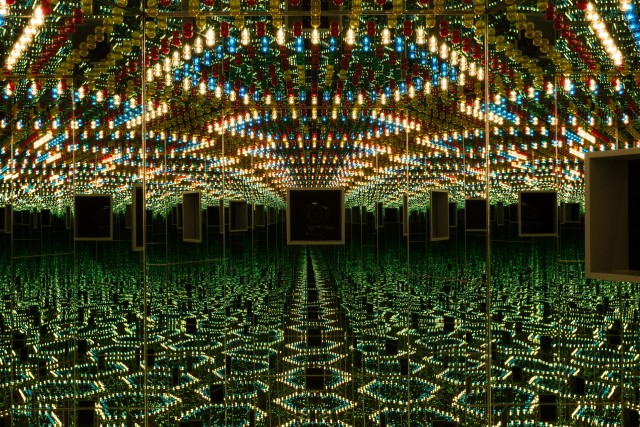
Another part of the exhibition is a video of Kusama called “Manhattan Suicide Addict” which places her at the centre of the show, reciting a poem that provides a perception into her world view. The work’s title is from her first, semi-autobiographical novel, published in 1978.
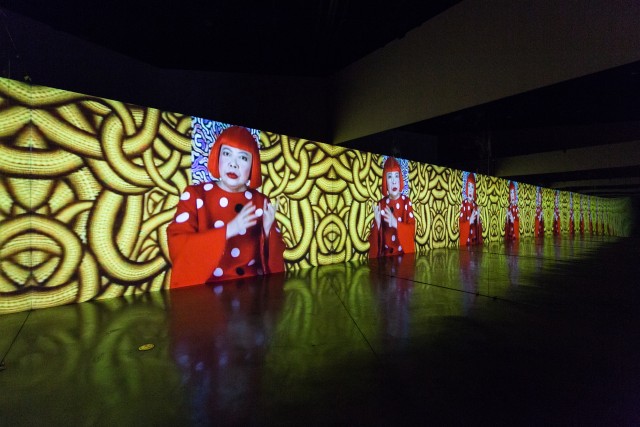
© https://artmuseum.daegu.go.kr/eng/exhibition/pop_exhibition1.html?cid=0&sid=41&gubun1=2&gubun2=2&start=
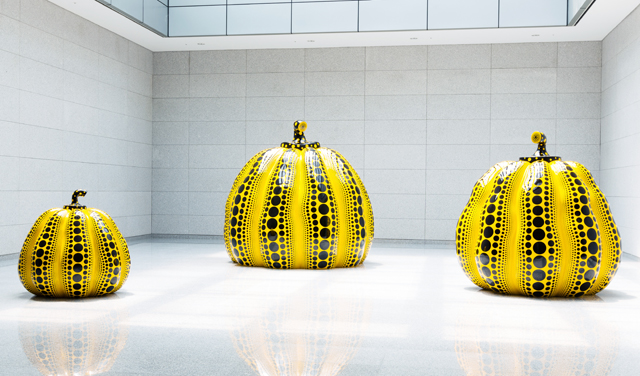
© https://artmuseum.daegu.go.kr/eng/exhibition/pop_exhibition1.html?cid=0&sid=41&gubun1=2&gubun2=2&start=
The show “ZERO: Countdown to Tomorrow, 1950s–60s” in 2014 was a large-scale historical exhibition dedicated to the German artists’ group Zero (1957-1966) founded by Heinz Mack and Otto Piene in 1961, Günther Uecker also joined the same year. ZERO was an international network of like-minded artists from Europe, Japan, and North and South America, some of the included artists were Yayoi Kusama, Piero Manzoni, Yves Klein & Lucio Fontana. The group wanted to redefine art in the aftermath of World War II. The exhibition showed 40 artists from 10 countries, various media including sculpture, painting, works on paper and installations were on show.
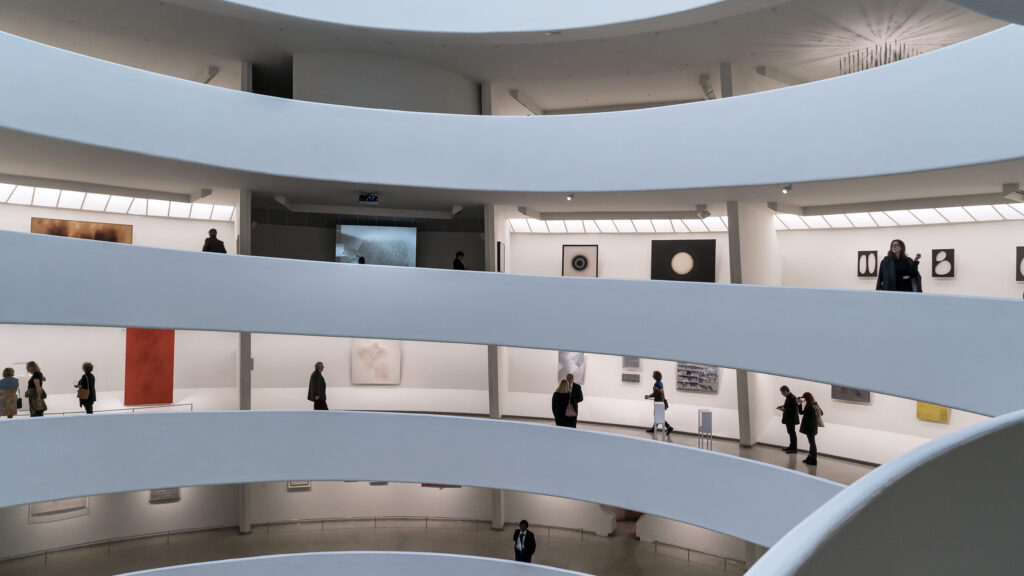

In 2015 Kusama had her first retrospective exhibition in Scandinavia at the Louisiana Museum of Modern Art. The show was called “Yayoi Kusama – In Infinity”. Kusama’s enduring fascination with infinity is a major theme of the exhibition, which unfolded chronologically. The first section was called Sprouts which was dedicated to her youth, showing some of her sketchbooks with nature subjects.
A few works were selected under the title Infinity, which included the “Infinity Nets” that became the artist’s breakthrough work. The installation “Polka Dot Love Room” (1967) was thoroughly restored for the Louisiana exhibition and was shown in its entirety for the first time since the 1960s.
Another section called Cosmos focuses on Kusama’s works in the 1980s, which were large scaled nature motives; a lot of these works had never been shown outside of Japan.
The last section was named Kusama’s World which brought her idea of self-obliteration through her spatial installations and performance videos into the spotlight.
A very important work is “Mirror Room (Pumpkin)” which was shown at the Venice Biennale in 1993 and gave Kusama the status that she has today.
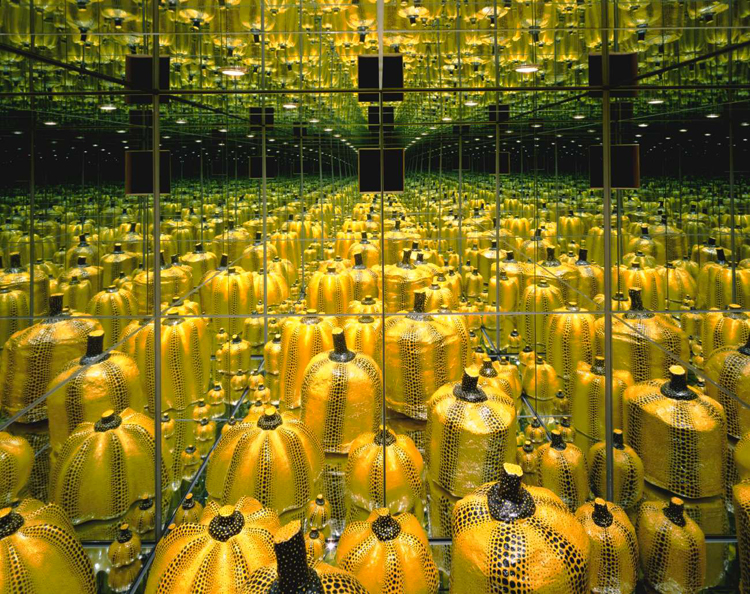
Yayoi Kusama was part of a lot of group exhibitions and also many solo shows, which I unfortunately couldn’t fit all in.
She still works a lot and had three major exhibitions in 2021, but you’ll learn more about them through my next blog! Here it is: https://arthotshot.com/yayoi-kusama-retrospectives-in-london-new-york-and-berlin-2021/.
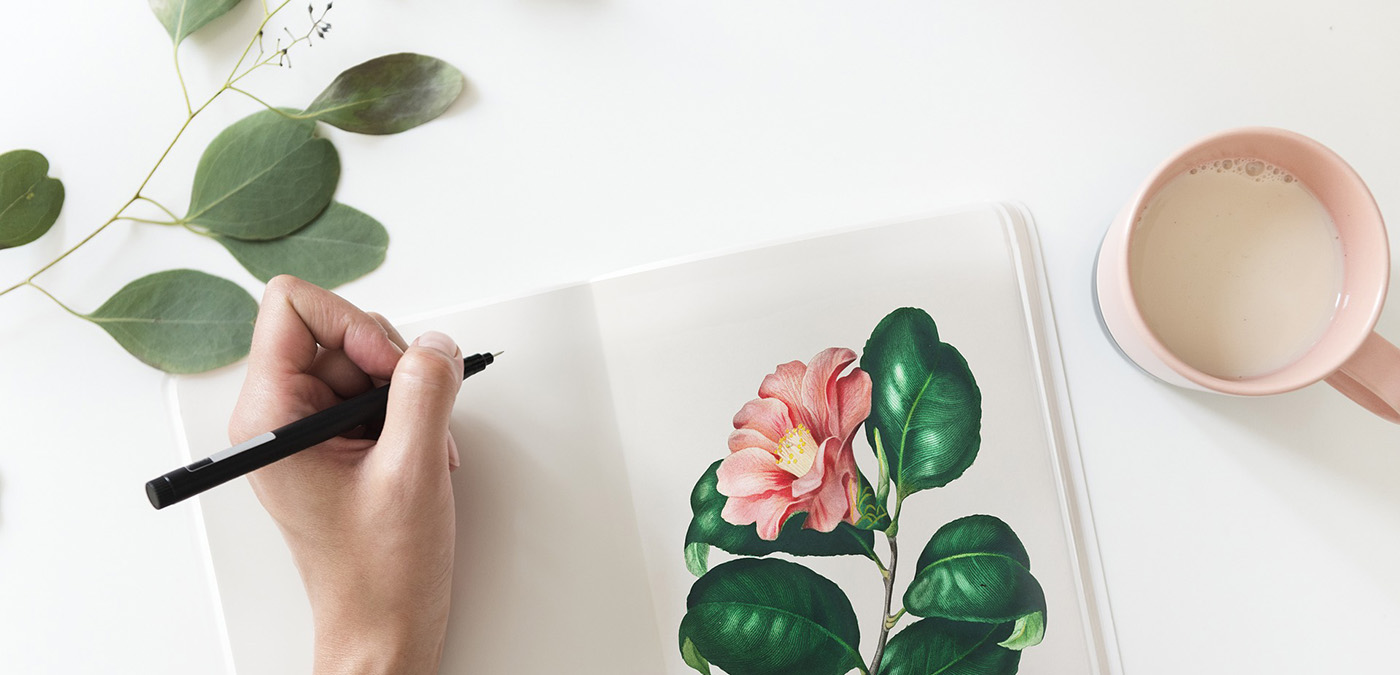
Comments
Great story Antonella, learned a lot reading it. Looking forward to your next Blog on that matter 👍